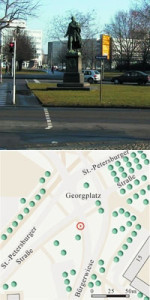 Since the mid-1930s, the municipal authorities had been getting ready to “deal with emergency situations after air raids”, and by 1943 at the latest they had begun taking further steps to be prepared for major air raids as well. An emergency committee consisting of the representative of the NSDAP, the police authorities, the emergency services and the municipal authorities was to coordinate the emergency assistance measures under the direction of Dresden’s mayor. A reserve post for the emergency committee was installed in the nearby Kreuzschule (Church of the Holy Cross School) on Georgplatz in the event that the city hall were to be destroyed. If the entire city centre were to be hit, a further reserve post in Leubnitz-Neuostra was ready.
Since the mid-1930s, the municipal authorities had been getting ready to “deal with emergency situations after air raids”, and by 1943 at the latest they had begun taking further steps to be prepared for major air raids as well. An emergency committee consisting of the representative of the NSDAP, the police authorities, the emergency services and the municipal authorities was to coordinate the emergency assistance measures under the direction of Dresden’s mayor. A reserve post for the emergency committee was installed in the nearby Kreuzschule (Church of the Holy Cross School) on Georgplatz in the event that the city hall were to be destroyed. If the entire city centre were to be hit, a further reserve post in Leubnitz-Neuostra was ready.
In sum, the municipal authorities prepared for the possibility of air raids in a long-term, comprehensive and painstaking manner, though their efforts were hampered in the course of the war by the ever more pressing shortages of labour, useable buildings and all other resources.
The emergency committee’s reserve post in the Kreuzschule was never used. When the city hall burned down during the night of 13 February 1945, the Kreuzschule caught fire as well.
Marked in 2001
